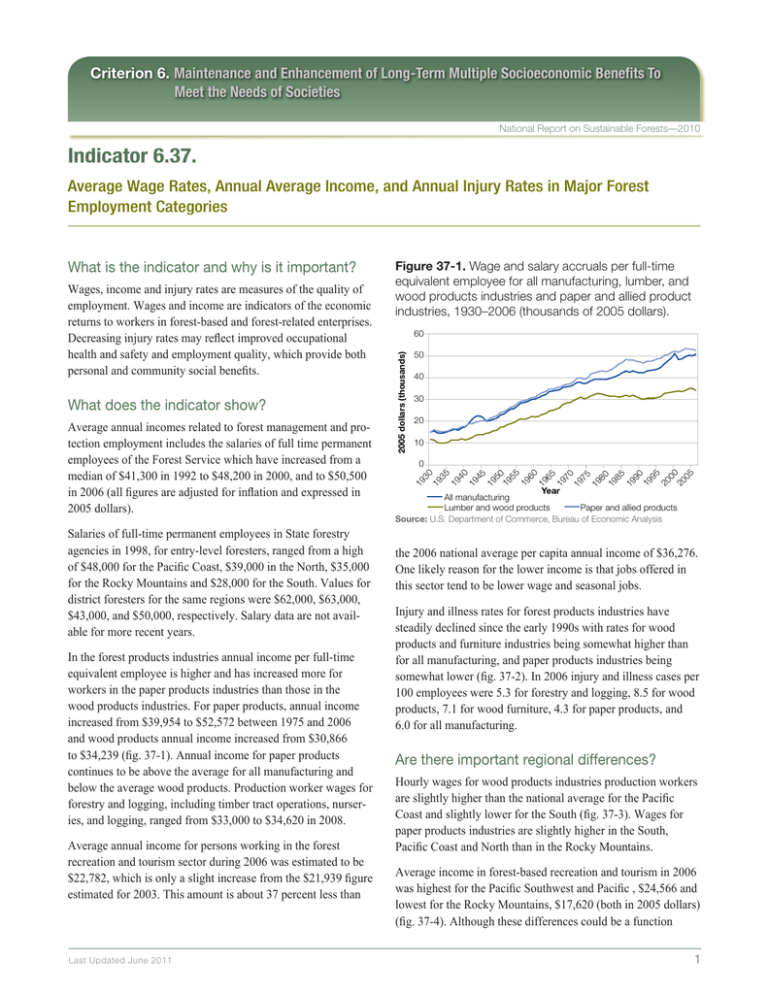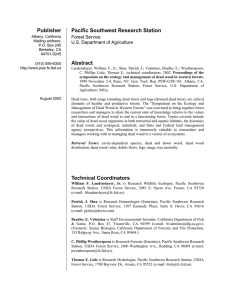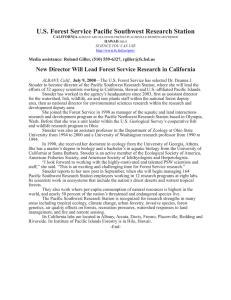Criterion 6. Maintenance and Enhancement of Long-Term Multiple Socioeconomic Benefits To
advertisement

Criterion 6. Maintenance and Enhancement of Long-Term Multiple Socioeconomic Benefits To Meet the Needs of Societies National Report on Sustainable Forests—2010 Indicator 6.37. Average Wage Rates, Annual Average Income, and Annual Injury Rates in Major Forest Employment Categories Average annual income for persons working in the forest recreation and tourism sector during 2006 was estimated to be $22,782, which is only a slight increase from the $21,939 figure estimated for 2003. This amount is about 37 percent less than Last Updated June 2011 Hourly wage in 2005 dollars 30 20 10 50 19 55 19 60 19 65 19 70 19 75 19 80 19 85 19 90 19 95 20 00 20 05 45 19 19 35 40 19 19 30 0 Year All manufacturing Paper and allied products Lumber and wood products Source: U.S. Department of Commerce, Bureau of Economic Analysis 20 15 10 5 0 Wood furniture 5 20 0 00 20 95 19 0 19 9 85 19 0 15 and illness rates for forest products industries have Injury steadily declined since the early 1990s with rates for wood 10 products and furniture industries being somewhat higher than for all 5 manufacturing, and paper products industries being somewhat lower (fig. 37-2). In 2006 injury and illness cases per 100 0employees were 5.3 for forestry and logging, 8.5 for wood products, 7.1 for wood furniture, 4.3 for paper products, and Year Limber and wood products Paper and allied products 6.0 for all manufacturing. All manufacturing Are there important regional differences? Hourly wages for wood products industries production workers are slightly higher than the national average for the Pacific Coast and slightly lower for the South (fig. 37-3). Wages for paper products industries are slightly higher in the South, Pacific Coast and North than in the Rocky Mountains. Average income in forest-based recreation and tourism in 2006 was highest for the Pacific Southwest and Pacific , $24,566 and lowest for the Rocky Mountains, $17,620 (both in 2005 dollars) (fig. 37-4). Although these differences could be a function 1 Annual income in 2005 dollars (thousands) the 25 2006 national average per capita annual income of $36,276. One likely reason for the lower income is that jobs offered in 20 this sector tend to be lower wage and seasonal jobs. 19 8 In the forest products industries annual income per full-time equivalent employee is higher and has increased more for workers in the paper products industries than those in the wood products industries. For paper products, annual income increased from $39,954 to $52,572 between 1975 and 2006 and wood products annual income increased from $30,866 to $34,239 (fig. 37-1). Annual income for paper products continues to be above the average for all manufacturing and below the average wood products. Production worker wages for forestry and logging, including timber tract operations, nurseries, and logging, ranged from $33,000 to $34,620 in 2008. 40 75 Salaries of full-time permanent employees in State forestry agencies in 1998, for entry-level foresters, ranged from a high of $48,000 for the Pacific Coast, $39,000 in the North, $35,000 for the Rocky Mountains and $28,000 for the South. Values for district foresters for the same regions were $62,000, $63,000, $43,000, and $50,000, respectively. Salary data are not available for more recent years. 2005 dollars (thousands) Average annual incomes related to forest management and protection employment includes the salaries of full time permanent employees of the Forest Service which have increased from a median of $41,300 in 1992 to $48,200 in 2000, and to $50,500 in 2006 (all figures are adjusted for inflation and expressed in 2005 dollars). 25 50 19 What does the indicator show? 60 Injury/illness per 100 workers Wages, income and injury rates are measures of the quality of employment. Wages and income are indicators of the economic returns to workers in forest-based and forest-related enterprises. Decreasing injury rates may reflect improved occupational health and safety and employment quality, which provide both personal and community social benefits. Figure 37-1. Wage and salary accruals per full-time equivalent employee for all manufacturing, lumber, and wood products industries and paper and allied product industries, 1930–2006 (thousands of 2005 dollars). 19 What is the indicator and why is it important? 30 25 20 15 10 5 0 45 50 19 55 19 60 19 65 19 70 19 75 19 80 19 85 19 90 19 95 20 00 20 05 19 19 35 40 19 30 19 19 Hourly wage in 2005 National Report on Sustainable Forests—2010 Figure 37-2. Rate of injury Year and illness cases per 100 All manufacturing full-time workers lumber paper Paper products, and allied products Lumber andfor wood productsand wood and allied products, and all manufacturing industries, 1976–2006. 10 of forest-based recreation and tourism demand driving labor 5 markets, fluctuations in regional economies are likely to be the major drivers of these rankings. 0 North South Pacific Rocky Why can’t the entire indicator be Coast reported atMountain Region this time? 25 Injury/illness per 100 workers 15 20 Wage and annual income estimates are not available for State forestry agencies, nonwood products industries, forestry schools in colleges and universities or for local governments 2003 2006 30 that contribute to forestry. Special surveys would be and NGOs required 25to collect this information. 15 10 5 Limber and wood products Wood furniture 05 20 00 95 20 Year 19 90 19 85 19 19 19 75 80 0 Paper and allied products All manufacturing Source: U.S. Bureau of Labor Statistics Annual income in 2005 dollars (thousands) 2005 doll 10 0 20 Injury rate information is not available for most forest 15 management jobs nor are they available for the nonwood 10 forest products sector or jobs in forest recreation and tourism jobs. Injuries for some forest management jobs are included 5 in wood0and paper industry data. Although nonwood forest North South Rocky Mountain Region Pacific Coast Figure 37-3. Wage per hour for production workers in wood products industries (left side) and paper products industries (right side) by region, 1997, 2002–2006. 25 oducts Hourly wage in 2005 dollars Hourly wage in 2005 dollars 99 9 5 95 20 2 00 00 20 2 0 05 00 5 25 oducts 2003 2004 2005 2006 2003 2004 2005 2006 15 15 10 10 5 5 Pacific Coast Pacific Coast Source: U.S. Department of Commerce, Bureau of Census North South North South Rocky Mountain Rocky Mountain Region Region Annual income Annual income in 2005 dollars (thousands) in 2005 dollars (thousands) Figure 37-4. Annual average income for persons employed in the forest recreation and tourism sector by region, 2003 and 2006. 2003 2006 5 2002 2002 20 0 20 2 05 00 1997 1997 20 0 d products dngproducts ng 20 30 2003 30 25 2006 25 20 15 10 10 5 0 South South Pacific Coast Pacific Coast Rocky Mountain Rocky Mountain products workers operate in the informal economy (not covered by traditional surveys), gathering products in the forest can be dangerous, and there are reports in the media of people becoming lost or injured every year. Relation to other indicators 20 15 50 North North North South North South Rocky Mountain Rocky RegionMountain Region Sources: USDA Forest Service analysis, multiple data sources Last Updated June 2011 Pacific Coast Pacific Coast The level of wages and income and level of injuries are a factor in the resilience of forest-based communities (Indicator 6.38) and a factor in the importance of forests to people (Indicator 6.44). The level of wages is influenced by the levels of capital investment (Indicator 6.34) and by the levels of education and research (Indicator 6.35). The level of wages in forest products industries may also be influenced by competition with other countries to provide products for the United States as indicated by trends in imports as a proportion of U.S. consumption (Indicator 6.32). 2 Nort



